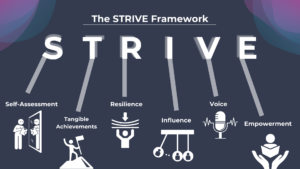When you’re in ‘stuck’ mode, hitting on a good idea can seem like a Grail quest. Other times, inspiration works overtime and you create more innovative ideas than you know what to do with.
While having an array of brilliant starting points is a fabulous thing indeed, sometimes their sheer abundance can lead you right back to stuck, either simply not knowing where to start, or overanalysing them until their fuelling
passion is dissolved. “We think good ideas to death, when we should be acting them to life,” says the king of thought-provoking quotes Brian G Jett.
In her webinar Generating ideas and choosing the right one Sara Parsons reveals the practical exercises that can help you whittle that pile of brainstorm post-its down to the one that deserves your action. Even if you’ve a tried
and tested technique for evaluating the most productive, noteworthy or viable of your ideas, avoid reaching for the usual methods – try something new!
Someone else’s shoes
This is a particularly useful technique if you’re individually trying to decide on a course of action. Look at all your ideas – perhaps lay them out visually on a flip chart – and ask yourself what someone else would do when faced with
this choice. That someone else could be anyone – Wonder Woman, Hilary Clinton or Lady Gaga!
It might be someone you admire or trust at work, or even someone from another department who has a completely different view of your organisation. Mix it up by flicking through a newspaper or magazine and thinking about the problem from
the points of view of the people within its pages, or type a few random letters into your workplace’s intranet directory to fall on a department or individual through whose eyes you could look at your smorgasbord of ideas.
You can also use this technique to evaluate your roster of ideas in a group situation too, dividing individuals, pairs or larger groups into thinking through the issue from a different perspective, adding a competitive edge to make it
more fun – Lex Luther versus Superman, Adam versus Eve, cats versus dogs!
Red, amber, green
Force field analysis is a technique whereby each potential idea is weighed up upon its ‘driving forces’ and ‘restrictive factors’. For example, one of your ideas for career advancement is to go on a presentation skills master class.
The driving factors might be:
- ‘boost my self esteem’
- ‘become more visible in my role’
- ‘meet likeminded peers’
The restricting factors are:
- ‘it’s expensive and I’m not sure the organisation will pay’
- ‘I might not get enough opportunities to practice my new skills, making it difficult to justify the expense’
- ‘I might suffer badly from nerves, creating a new problem for myself’
Finally, use a traffic light system to establish where there are blockages (red), where there’s potential to steam ahead (green), and where there may be unknowns or ambiguities which will require more thinking or research (amber).
Game, set and match
A technique called ‘paired rankings’ is useful if group think or individual bias towards a particular idea is creeping in and you want to ensure all options have been fully explored before a decision is made. For example: you’re not
sure which type of venue would be best for your graduate training programme welcome day.
The options are:
- the company boardroom
- offsite in an impressive corporate environment
- offsite in a fun, quirky, creative venue, the office cafeteria, or in the open air
Group two ideas together at random and select individuals to argue for each idea, debate-style; it can be useful to encourage someone to argue for an idea they’ve previously been against in order to eek out new perspectives. Once a
winner emerges from the first pairing, the next idea takes the ring, and so on until an overall winner emerges.
Reach for the stars
Ensure everyone gets a say in a group evaluation by giving everyone three stars. Each individual can draw their stars next to their favoured ideas, in whichever weighting system they choose – one might give one star each to their three
preferred ideas; one might decide to award all three to their standout idea; or two stars to the top idea and another to a close second or a wild card choice.
The most starred idea by the group emerges as the actionable idea and all that remains is to make it happen.
Rhyme and reason
When you’re communicating upwards your own or your team’s actionable idea, sometimes it’s necessary to ‘show your workings out’, so to speak.
A great way to instil confidence in your idea is to demonstrate that all other options have been explored and the reasons they didn’t make the shortfall.
Low importance essential
| High importance essential |
Low importance non essential
| Non essential high importance |
Create a grid of four boxes. In the top left slot in your ‘low importance essentials’; those ideas that everyone agrees must happen at some point but for whatever reason – personal, logistical, cultural, organisational – aren’t for
right now. In the top right plot your ‘high important essentials’; things that are crucial and must happen now.
In the bottom left you have your ‘low importance non essentials’; the ‘nice to have’s that just aren’t the right solution at this time. Finally, in the bottom right your ‘non essential high importance’ items are those that might not
seem crucial on face value, but demands dictate they must be implemented right away.
The standout ideas emerge from the relevant plotting, and if you’re probed as to your reasoning, the overall grid gives a good indication of the measures behind your thinking.
More on creative thinking on the everywoman Network:
7 ways to unleash your team’s creative side
The da Vinci career code: exercises for creative geniuses





